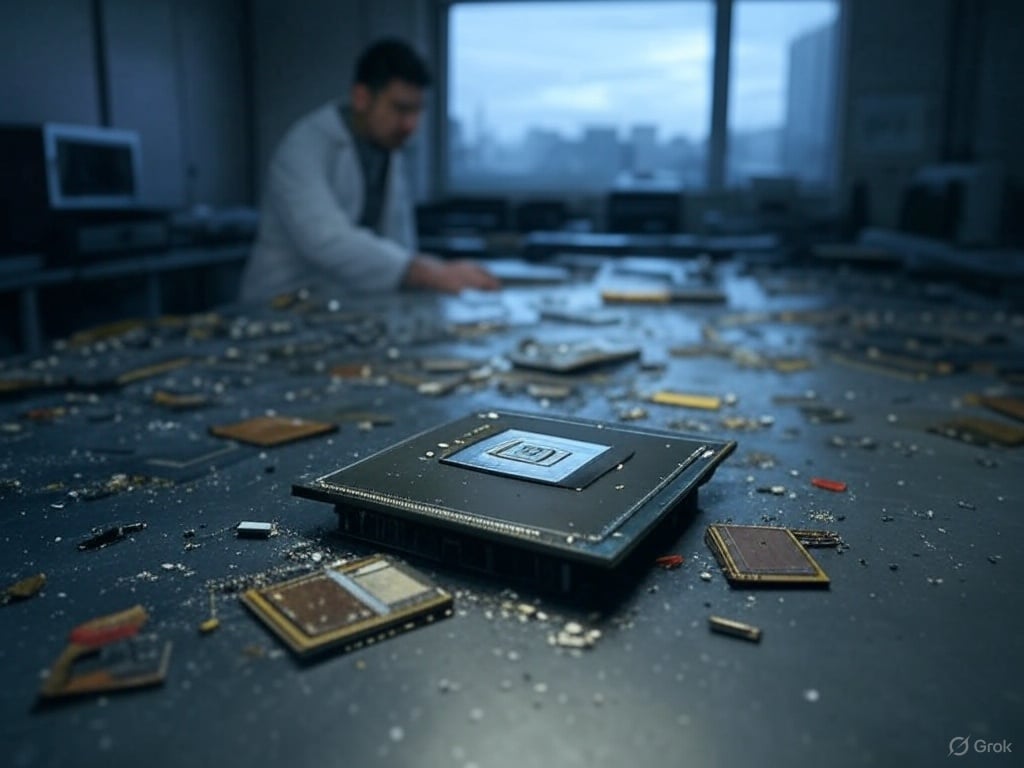The crisis currently facing Intel has triggered an unusual phenomenon in the tech industry: a mass exodus of its top engineers to direct competitors, led by Samsung. The South Korean giant, aiming to strengthen its presence in the U.S. semiconductor market, is taking advantage of this talent drain to recruit highly specialized profiles in critical technologies such as EUV photolithography, advanced chip packaging, and backside power delivery (BSPDN).
Intel is going through turbulent times. Under the leadership of current CEO Ribu Tan, the company has announced aggressive restructuring plans, canceling strategic projects and making drastic cuts to its workforce. The declared goal is to cut costs and redirect resources after Tan described recent capacity investments as “reckless overinvestment” in manufacturing over the past few years.
The adjustment plan includes layoffs of up to 75,000 employees worldwide, highlighting the severity of the crisis. While a significant portion of these cuts target administrative and support roles, the talent flight has also affected key R&D teams. Engineers with decades of experience in cutting-edge technologies are leaving, dealing a hard blow to Intel’s technological leadership.
The departure of elite engineers from Intel has not gone unnoticed in the industry. Samsung Electronics and Samsung Electro-Mechanics, with their U.S. divisions, have launched an aggressive talent acquisition campaign. Their goal is to strengthen areas where the South Korean company still lacks the depth and experience that characterize Intel.
Among the most sought-after profiles are experts in next-generation semiconductor packaging—an essential field in the post-Moore era, where transistor miniaturization alone no longer suffices to boost performance. Technologies like EMIB (Embedded Multi-Die Interconnect Bridge) and glass substrates are considered strategic for manufacturing more efficient and powerful chips.
In this context, Samsung has already managed to bring in renowned figures. One of the most talked-about hires is a veteran engineer specialized in EMIB, who recently joined the company’s foundry division. Another notable case is Gang Duan, formerly a leading manager in advanced packaging at Intel, who has joined Samsung Electro-Mechanics in the U.S. to lead technological marketing and application engineering.
This movement reflects fierce global competition in the semiconductor sector. While Intel struggles to regain its footing after years of delays in its process nodes, Samsung and TSMC are consolidating their leadership in advanced manufacturing. Bringing in talent from Intel allows Samsung to accelerate its learning curve and narrow the gap in key innovation areas.
Intel engineers bring not only technical expertise but also a well-established research culture in critical microelectronics fields. For Samsung, which has invested heavily in expanding its manufacturing capacity in the U.S.—with factories in Texas and plans for new facilities—this transfer of talent could be a decisive advantage over competitors.
However, there are concerns within Samsung. Some executives emphasize that hiring indiscriminately is not enough: the challenge lies in selecting professionals who fit specific projects and can adapt to South Korea’s more hierarchical and rigid corporate culture compared to Silicon Valley.
In recent years, there have been cases of foreign engineers leaving Samsung shortly after joining, due to integration difficulties. The company recognizes that success depends not just on attracting talent but also on retaining it.
This phenomenon is occurring at a time when geopolitics influence the semiconductor industry more than ever. The U.S. promotes its own technology sovereignty strategy through the CHIPS and Science Act, encouraging local production and seeking to reduce dependence on Asia. In this context, Samsung, which has received aid for its U.S. factories, needs to reinforce its local teams to meet production and development goals.
Meanwhile, Intel faces an existential dilemma. Although still a key player, its ability to compete in advanced nodes has been questioned. Without stemming the talent hemorrhage, its disadvantage against rivals like Samsung or TSMC could become irreversible.
The brain drain from Intel to Samsung is more than a corporate episode; it signals a profound transformation in the semiconductor industry. Highly qualified talent has become as strategic a resource as manufacturing facilities. In an industry where development timelines span decades and investments reach billions, losing or gaining a team of engineers can tilt the global competitive balance.
Furthermore, this dynamic introduces a human element into an industry often narrated through numbers and silicon. Behind each restructuring decision are careers, accumulated knowledge, and a struggle for survival in the most strategic market of the 21st century.
Frequently Asked Questions (FAQ)
Why is Intel losing so many key engineers?
The company is undergoing internal restructuring with massive layoffs and project cancellations. This creates uncertainty, prompting many professionals to seek opportunities elsewhere, such as at Samsung.Which technological areas are most attractive to Samsung from Intel engineers?
Samsung is especially interested in experts in advanced semiconductor packaging, glass substrate technologies, and backside power delivery systems (BSPDN)—all critical for next-generation chips.What risks does Samsung face by absorbing talent from Intel?
The main challenge is cultural and professional integration. Not all Intel engineers adapt easily to Samsung’s more rigid and hierarchical organizational model, which differs from Silicon Valley’s more flexible environment.What impact could this exodus have on the semiconductor industry?
Strategic talent transfers could accelerate innovation at Samsung while weakening Intel’s position in critical areas, potentially reshaping global competition in a sector vital for the economy and geopolitics.

